|
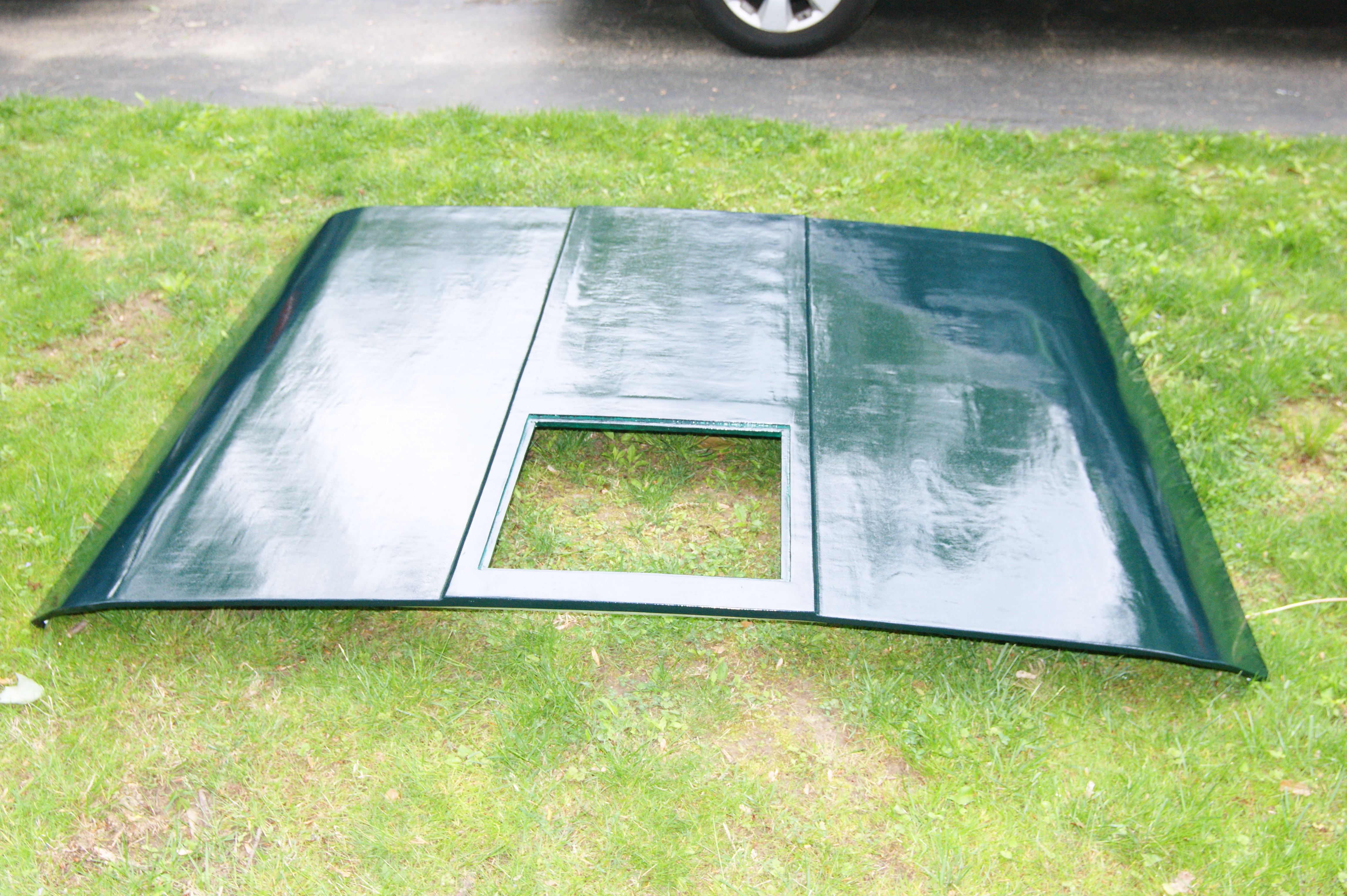 The Hardtop Bimini is something I always liked about Ron Minchin's Pearson 35.
Ron built his hardtop Bimini after first building a hardtop dodger. I am
doing the Bimini first so that I have someplace to mount two 140 watt solar
panels. This is not a project for the faint at heart. I started in
February and will be lucky to be done by mid May. The main reason for
delay? ...design as you go. There are so many options and ways to construct a
Bimini hardtop that for someone who needs to weigh all decisions, it can take a
while to process all of the design choices and construction technique. I
used water to help soften the panels so they would accept the frame curvature
better without breaking but that caused a little warp in one panel which had to
be faired out. The panel that did not warp, cracked a little so that
required a little fixing. All of this took time. The Hardtop Bimini is something I always liked about Ron Minchin's Pearson 35.
Ron built his hardtop Bimini after first building a hardtop dodger. I am
doing the Bimini first so that I have someplace to mount two 140 watt solar
panels. This is not a project for the faint at heart. I started in
February and will be lucky to be done by mid May. The main reason for
delay? ...design as you go. There are so many options and ways to construct a
Bimini hardtop that for someone who needs to weigh all decisions, it can take a
while to process all of the design choices and construction technique. I
used water to help soften the panels so they would accept the frame curvature
better without breaking but that caused a little warp in one panel which had to
be faired out. The panel that did not warp, cracked a little so that
required a little fixing. All of this took time.
In building a hardtop Bimini that is strong enough to support itself and 53
pounds of solar panels, there are many challenges. The weight of the top is estimated
to be 40-50 lbs. This means the full setup (with wires, panels, panel mounts,
extra tubing, etc...) will weigh in at about 100-120 lbs. I was concerned
about this much weight aft and Tom W said we would not notice it. It would
be like having a kid or Great Dane in the cockpit. No problem. It is
weight up high, but it does not increase healing force until it goes past 25
degrees. Once again, no problem.
First, I did not want to spend the money for a new Bimini frame, so I reinforce the
existing 7/8" tube frame with thin walled 1" SS tubing.
Tom Wright at Cedar Creek Sailing Center can get SS thin walled tubing and
Hunter Sailboat Owners Chandlery shop had a good price for 6 foot lengths ($25)
so I ordered 6; 4 for the main down tubes, the remaining tubes will be used to
help attach the frame to the stern rail system. I may have gotten a better frame
with a new thick walled 1 inch frame, but this will do well enough.
tubing and
Hunter Sailboat Owners Chandlery shop had a good price for 6 foot lengths ($25)
so I ordered 6; 4 for the main down tubes, the remaining tubes will be used to
help attach the frame to the stern rail system. I may have gotten a better frame
with a new thick walled 1 inch frame, but this will do well enough.
It was then a matter of measuring the frame in such a way as to prevent
interference with the boom and the split backstays. Centering the top was
also a challenge since there really isn't a reference point on the frame to
measure from except the ends of the frame tubes. The width between stays and the span
between bows would set the dimensions of the top. So I went to the boat on
a cold February weekend, installed the cloth Bimini, then built a wooden frame
on top of the bows out of 1x2" pine to mark the frame locations. The split
backstay was handy in that it was perpendicular to the length of the boat.
Once marked, I cut notches in the 1x2 strips
with a 15/16" spade bit and saber saw, nailed a bridge piece between strips
(which formed a ladder of sorts with stringers and treads), then mounted the
ladder to the underside of the hoops with string From this mock-up I was able measure width and length; 5' 6" x 7'. To
achieve the width I used 1x2" cypress with dado groves to join the 2 32" wide
plywood sheets to the a center 21.5" wide sheet. I had originally intended
to use 1/4" cork on the full top, but change my mind to use the cork only in the
center section. Then the side pieces turned out to be a bit too wide.
So I trimmed the outer edges off and used it to mount to the underside of the
From this mock-up I was able measure width and length; 5' 6" x 7'. To
achieve the width I used 1x2" cypress with dado groves to join the 2 32" wide
plywood sheets to the a center 21.5" wide sheet. I had originally intended
to use 1/4" cork on the full top, but change my mind to use the cork only in the
center section. Then the side pieces turned out to be a bit too wide.
So I trimmed the outer edges off and used it to mount to the underside of the top to provide something to attach side curtains and attach the frame to.
Then to get the angle right to meet the frame, I knocked a corner off and saved
the strips for later.
top to provide something to attach side curtains and attach the frame to.
Then to get the angle right to meet the frame, I knocked a corner off and saved
the strips for later.

To allow the 1/4" marine mahogany plywood to take the shape of the curve
of the frame hoops (in addition to wetting with water), I cut kerfs into the plywood
0.5" appart, bent the plywood onto the frame
and clamped it to the frame. This allowed me to stuff the open kerfs with
epoxy mixed with wood flour after the plywood dryed. I have buckets of
sawdust from under
the table saw. I first screened the flour to make sure there were no large
chunks.

 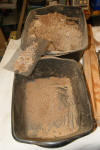
To add strength to the kerfed and stuffed panels once curved, stuffed and
dried, I covered them with 6oz
fiberglass cloth and polyester resin. This was a mistake. I should
have used West Systems epoxy through out. The polyester resin would not
set on the panels. It acted like laminator's resin which does not set when
exposed to air. It was stiff, but tacky. The resin in the pot kicked
and was hard as a rock, but he thinner layers would not. So after after
three subsequent coats of resin, raising the temp in the basement to 70 degrees,
using a heat gun, waiting weeks, and it still not setting, I treated it like
laminator's resin and covered it with fairing compound and the miracle happened;
it cured. The surface needed some fairing anyway so nothing lost in
material. Just took a while to figure out the problem. The resin
wetted cloth cloth was wrapped around the lower edge of the panel and stuff into
the gap between the cypress and plywood with strips saved earlier.
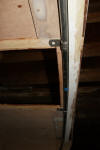
I epoxied 1 inch PVC (cut 2" wide with a 45 degree angle on one long side) lumber fore and aft to the underside to provide the
frame something to stop against. Before mounting the PVC I installed a 6"
wide 1/4" panel on both side of the mid section (fore and after) so that the was
a continuous flush surface to mount the tubing to. The frame is attached to the top
with stainless steel tubing tie-downs, but I also used 2x2 with a notch cut in
it for temporary mounting brackets.  The open hole will have smoked 1/4" makrolon (Lexan) installed after I have the
Bimini
installed on the boat. I need to make sure the back-stays fit as measured.
I will need to arch the Lexan to match the curve of the frame so I intend to use
a heat gun, clamps and time. This is the sight panel to allow us to see
the mainsail tell tails and the wind-vane.
The open hole will have smoked 1/4" makrolon (Lexan) installed after I have the
Bimini
installed on the boat. I need to make sure the back-stays fit as measured.
I will need to arch the Lexan to match the curve of the frame so I intend to use
a heat gun, clamps and time. This is the sight panel to allow us to see
the mainsail tell tails and the wind-vane.
The other detail was softening the interface on each side of the center
section.
I used West Systems Epoxy and 410 filler/thickener to make the fairing compound. The rounded corner of the bondo plastic spatula
was used for the radius of the softened curve.
make the fairing compound. The rounded corner of the bondo plastic spatula
was used for the radius of the softened curve.
 Cork
center panel visible. Cork is 1/3rd the weight of 1/4 inch plywood.
I only save about 2 pounds in the center section but I had the cork and wanted
to see how it would work. It is flexible, can be sanded easily, and takes
fairing compound well. So it was worth a shot in this small section. Cork
center panel visible. Cork is 1/3rd the weight of 1/4 inch plywood.
I only save about 2 pounds in the center section but I had the cork and wanted
to see how it would work. It is flexible, can be sanded easily, and takes
fairing compound well. So it was worth a shot in this small section.
Additional pictures below. I will update this article once I have the
top hauled out of the basement (yes I tested the removal before start the final
assembly). Once the top is outside, I will prime with awlgrip primer and
top coat with Awlgrip Forest Green finish coat.
 Showing
the brass let-ins going through 2 layers of 1/4 Marine plywood. Cork used
in the corners for flexability. Showing
the brass let-ins going through 2 layers of 1/4 Marine plywood. Cork used
in the corners for flexability.
 The
fully primed underside. The groves in the corner cork layer allow a more
gradual bend in the plywood. Gradual bends help to avoid breaking the
plywood at the kerf cuts. The
fully primed underside. The groves in the corner cork layer allow a more
gradual bend in the plywood. Gradual bends help to avoid breaking the
plywood at the kerf cuts.
 Cove
bead where single layer meets double. Cove
bead where single layer meets double.
 Fully
primed topside Fully
primed topside
 Another
topside view. Another
topside view.

This update is about putting on the finish color coats of Awlgrip, mounting the
solar panels to the top, and installing the bimini on the boat. In short, it is
now functioning in the capacity for which it was designed; shelter and solar
panel support.
After 3 coats of
primer were put down on all surfaces of the bimini, I sanded it with 220 grit
sand paper. The bottom side then got 2 coats of Awlgrip Mediterranean White and
the top side received 4 coats of Dark Green (if I had used a dark primer, fewer
coats of the Dark Green would have been needed. The important thing is the
coverage (no light spots) and a good shine to the finish.
 Before
mounting the panels to the top I had to make the brackets to support the
panels. Hotwire sold me z-brackets they said would adjust to the curvature of
the top. However, they would Before
mounting the panels to the top I had to make the brackets to support the
panels. Hotwire sold me z-brackets they said would adjust to the curvature of
the top. However, they would  not do at all. What worked was a mount design of my own. I combined 1.5"x4"
aluminum angle bar purchased from Home-Depot in a 4 foot section, and1.5"x4"
aluminum hinge.
These were cut from a blank 4’ hinge purchased from Grainger. I needed a total
of 8 pieces of each (4 each for each panel). I used the blank hinge so that I
could drill my own holes for bolting. Each bracket hinge pair took 6 nuts and
bolts and washers. The pictures below show the mounted panels and some hinge
action.
not do at all. What worked was a mount design of my own. I combined 1.5"x4"
aluminum angle bar purchased from Home-Depot in a 4 foot section, and1.5"x4"
aluminum hinge.
These were cut from a blank 4’ hinge purchased from Grainger. I needed a total
of 8 pieces of each (4 each for each panel). I used the blank hinge so that I
could drill my own holes for bolting. Each bracket hinge pair took 6 nuts and
bolts and washers. The pictures below show the mounted panels and some hinge
action.
 
The holes for the backstay where drilled with a 1 1/8th
inch hole saw bit, at the same angle as the backstays, and just nicking the
corners of the port light window support ledges. Then with a small hand saw, I
cut a 1/4" slot in each corner for the backstay to slip through and into the
center of the inch and one eighth hole.. After the brackets holding the frame to
the top were attached (mounting the top the frame), the frame was secured
(braced) to the stern rails in two places each side. These braces allowed us to
make minor adjustments in pitch and yaw of top to keep the stays I the center of
the holes.
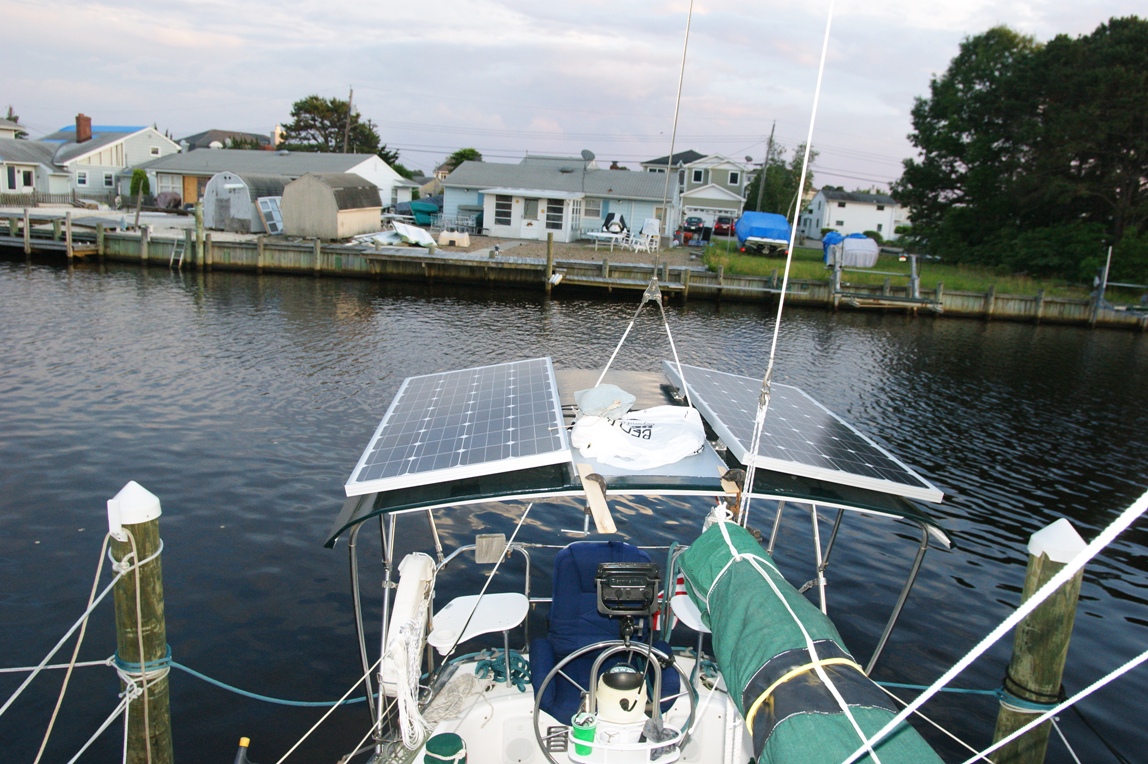
The ¼” Makrolon tell-tail sight port panel is mounted in the opening. I used
clamps to hold down the "Lexan" to butyl tape and elastomeric caulk, on the fore
end and weight on the aft end (tool bags in a plastic shopping bag). However, I
did need to fashion SS hold-down brackets to keep the panel in the frame. The
Lexan wanted to return to its flat state but the top was curved. The brackets
held it in place. Each solar panel's leads were connected to y-junctions so that
only one cable was run down each leg of the backstay and to the charge
controller; BlueSky 2512i (25 amp, 12 volt). I also mounted a Victron BMV 602
battery monitor to keep track of the comings and goings of the electrons in the
batteries.
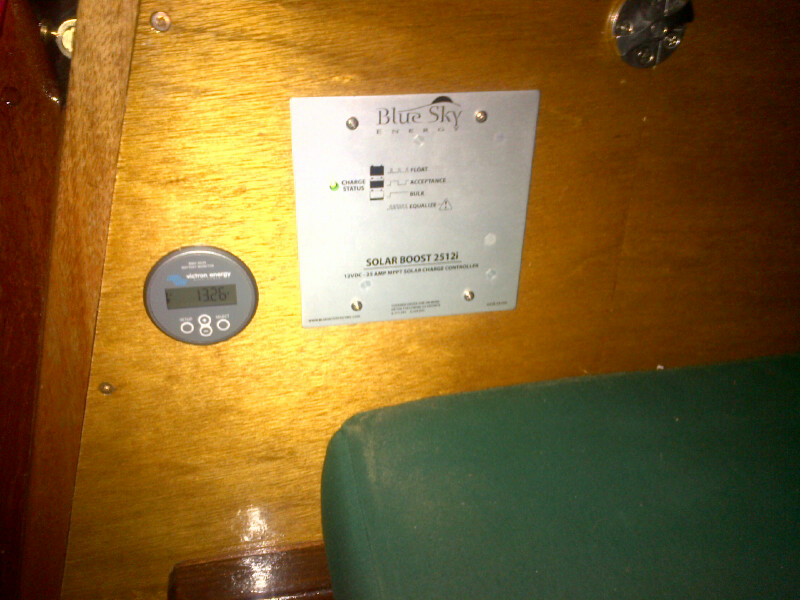
|